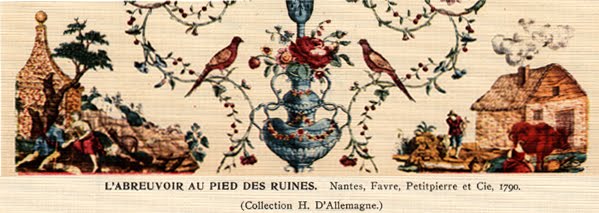In Damask, Thread Count Is Essential
:~~~~~:~~~~~:~~~~~:~~~~~:~~~~~:~~~~~:~~~~~:
Thread count is the number of threads in a square inch of cloth. To calculate it, add the number of warp threads to the number of weft threads. You can use a loupe, but a graduated linen tester is easier on the eyes. Or, as here, a flat ruler marked in sixteenths of an inch on a scanner.
:~~~~~:~~~~~:~~~~~:~~~~~:~~~~~:~~~~~:~~~~~:
As an approximate guide, single damask should range between 100 to 200 threads per inch. Some antique single damasks are even overwefted (more weft threads than warp threads) though not as frequently as double damask. Beware lower quality single damasks are under wefted (less weft threads than warp), leaving threads that over time are likely to shift and separate. If they haven’t already.:~~~~~:~~~~~:~~~~~:~~~~~:~~~~~:~~~~~:~~~~~:
Double damasks should be between 165 to 400 threads per inch. Double damasks below 180 should be used carefully. They are too loose for long-term use.
In the photos of antique and vintage linens above, the A napkin on the left is a single damasks with a thread count of 192, 96 warp and 96 weft threads per inch. The second napkin, D, is a high quality double damask, with a thread count of 256, 112 warp and 144 weft threads. The third, E, is a French damask with 320 threads per inch, 144 warps and 176 wefts. The ruled scans are of one quarter inch square of each napkin. The graduations are for 1/16 inch. Notice the higher the thread count, the more luminous the linen.
Even with the aid of a linen tester and a scanner, I can’t guarantee these counts aren’t off by a few threads. The antique linens have been used and long lived with fibers only softened by age. But the counts are close enough to judge quality.
Patterns ~ More is Better
It is the pattern that gives linen damask its character. Images coquettishly appear and disappear, turn from matte to satin as the light, or the admirer, changes angles to the cloth.
The more detailed the pattern, the more valuable the cloth. Detailed patterns with sharp, crisp contrast take more set-up and weaving time for the looms. The old, fine scrolling patterns shout double damask as they could not be made without the fine threads and overwefting of the double damask weave. Look for the size and complexity of repeats in the pattern. Larger repeats mean more work; more investment always means better quality.
Quality tablecloth patterns fit the cloth. They could have been woven to a standard size or custom woven. Whether you call it framed or mitered, good cloths have patterns on all sides. If the pattern follows the sides then runs straight off the end, it was made from bulk yard goods that allowed minimal weaving and could be cut to any length.
Motifs also add value. The vast majority of antique and vintage cloths are floral. Figural cloths, more scarce, are therefore more valuable. Hunt scenes, mainly deer-hunt scenes, were among the first linen damasks in the 16th century. They were popular, especially the German hunt scenes, all through the 19th century. Figurated or storied cloths were also popular during the same period. Their category is self-descriptive; stories told in pictures woven are into the cloth, in usually two mirrored repeats with a central motif.
Small signs that add up
Sometimes it’s as small as seeing hand sewn hems. Even the best linen often leaves the selvages raw and the hems less than a quarter of an inch to preserve as much of the precious damask as possible.Hallmarks, or mill marks, are only found on quality cloths. The tiny trademarks woven into corners of tablecloths and napkins are easy to miss and even harder to identify more than a handful with a particular linen company.
The photos above show millmarks woven in the corners of two Irish linen napkins. The left is that of Ross Brothers Linen Co., Belfast. On the right is the lion rampant of Richlin Textiles, Ballymena.
Quality Always Shows
Most countries in Northern and Eastern Europe grow flax and weave linen, perhaps not as well or as much as they have in decades and centuries past, but they do. In recent years, linen yarns have been imported into European countries from India and China to be woven, bleached and finished.In the absence of tags or labels, identifying a country of origin is through experience, more an art than a science.
But quality can be identified, from no matter where.




